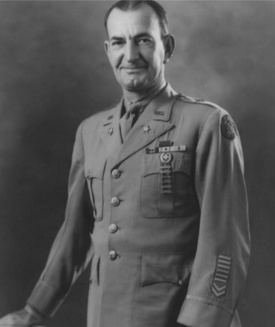A few years ago, my wife and I visited the Punchbowl Cemetery in Hawaii in search of her grandparents’ grave. At the visitor’s center, we were met by two Japanese American (JA) World War II veterans. When I mentioned we were searching for Brigadier General Kendall Jordan Fielder’s grave, one of them responded, “Oh! He saved our bacon several times during World War II.” Without Fielder’s influence in the early days of World War II, the fate of nearly 160,000 people of Japanese descent in Hawaii, might have been drastically different.
In November 1938, “Wooch,” a nickname from his football days at Georgia Tech, was assigned to the 22nd Brigade at Schofield Barracks in Hawaii, where he helped train JA soldiers in the 298th National Guard Infantry Regiment. In his own words, “As I worked with them, I discovered that they were as good soldiers as one could find anywhere in the army.”
In February 1941, Lieutenant General Walter Short became Commanding General of the Hawaiian Department and picked Lieutenant Colonel Fielder as his Assistant Chief of Staff, G-2 (Intelligence). In the months leading up to Pearl Harbor, Wooch became an active member of the Committee of Inter-Racial Unity, one of many advisory groups to FBI Chief Robert Shivers to study and encourage racial harmony among the various ethnic groups on the islands.
With the attack on Pearl Harbor, it became Wooch’s responsibility to dispel the many rumors and encourage calm among the residents. He investigated allegations of espionage and sabotage, worked with the press to ensure accurate reporting, and gave two radio addresses to calm the fears of the population.
On December 18, 1941, General Delos Emmons, Short’s replacement, formed a Public Morale Division in the Territorial Office of Civilian Defense. Hung Wai Ching, Charles Loomis, and Shigeo Yoshida were appointed to the renamed Morale Section, whose responsibilities included race relation recommendations to Fielder, who fought the battles up the military chain of command. In many cases, he met substantial resistance from his military superiors.
Emmons had his marching orders from the President which included mass internment of Hawaii’s Japanese population on Molokai Island or stateside. Fielder, FBI agent Shivers, and others argued against it. It fell to Fielder, as Emmons’ military internal security advisor, to convince the general to resist the pressure up the military chain of command to the President. Hung Wai Ching related that he did not know why Fielder was not relieved of his duties or court martialed during this period. John Burns, head of the Honolulu Police Contact Group and later Hawaii’s Governor, also confirmed the arguments between the two and that Fielder was “a man of exemplary courage and an outstanding American” for his actions countering the general.
On January 21, 1942, JAs were released from the Hawaii Territorial Guard, including Reserve Officer Training Corps (ROTC) students. With the urging of the Morale Section’s Hung Wai Ching, 169 ROTC members at the University of Hawaii signed a petition to form a non-combat labor battalion. Ching submitted the petition to Fielder, who in turn convinced Emmons to form the “Varsity Victory Volunteers (VVV).”
Next, Fielder and others convinced General Emmons that a Nisei combat unit should be formed from JAs in the Hawaii National Guard. Emmons ordered Fielder to Washington to convince Army Chief of Staff General George Marshall to form the unit. Marshall’s reaction to Fielder’s presentation was “That’s a wonderful idea! Why didn’t someone think of it before?“ Thus, a provisional infantry battalion of JAs was formed and sent to the mainland for training on June 6, 1942, and later designated the 100th Infantry Battalion.
Later that year, Assistant Secretary of War McCloy visited Hawaii. Fielder arranged to have Ching take McCloy to see the VVV men at work and to convince him of their suitability as loyal soldiers. Also, in 1942, Fielder arranged a meeting in Hawaii of Ching, Yoshida, and Masa Katagiri with first lady Eleanor Roosevelt to discuss JA issues. She promised to inform the President of the issues, which lead to a meeting between the President and Ching in Washington.
The successes of the VVV, the 100th Battalion, and the meetings with policy makers helped influence the creation of the 442nd Regimental Combat Team (the 100th Battalion became the regiment’s first battalion). Fielder and Emmons fully endorsed efforts on the mainland to form the unit. On January 1, 1943, Marshall ordered the formation of the unit.
Throughout the war, Fielder kept track of the 100th and 442nd in Europe, explaining to Emmons and others that they were “my boys.” Following the war, Fielder was charged with assisting with the review of the 442nd by President Truman upon the unit’s return to the states. In Hawaii, returning 442nd veterans formed Club 100 and the 442nd Veteran’s Club. Fielder was elected as a charter honorary member in both clubs and was an active member the rest of his life.
History might have been very different were it not for Fielder and other champions of the Japanese American people in Hawaii. While Wooch was often given credit for saving their “bacon,” he was quick to say he was only one of many people who played a part in preventing mass internment on the islands and in forming the fabled VVV, 100th Battalion, and 442nd Regimental Combat Team. On April 13, 1981, Fielder passed away. His obituary in the Honolulu Star-Bulletin on the 16th perhaps said it best: “Omar Bradley, who died last week, was called the “GI general of World War II. ‘Wooch’ Fielder might equally be called “Hawaii’s colonel.”
*This article was originally published in JAVA Round Robin and The Advocate, Spring 2017.
© 2019 Dwight H. Gates / JAVA




